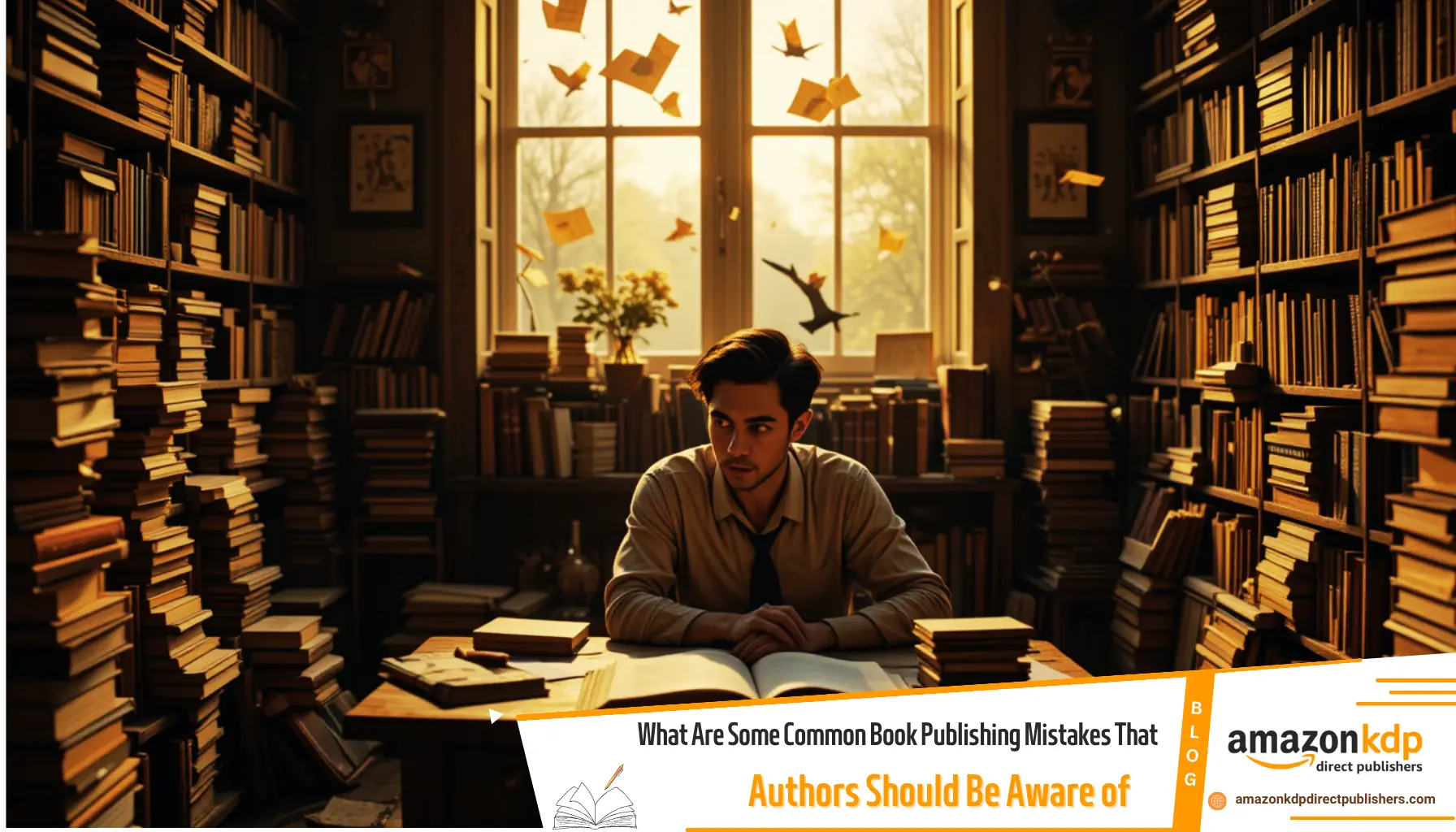How to Avoid Common Book Publishing Mistakes
When it comes to publishing a book, authors—especially first-timers—often make crucial mistakes that can derail their success. So, what are some common book publishing mistakes that authors should be aware of? The biggest errors include rushing to publish, skipping professional editing, designing their own covers without expertise, and neglecting marketing altogether. These missteps can cost you credibility, readers, and revenue. In this post, we’ll break down the top mistakes authors make and show you how to sidestep them like a pro.
1. Rushing to Publish Too Early
There’s a special kind of excitement that comes with finishing your manuscript. But don’t let that buzz tempt you into publishing it immediately. One of the most common book publishing mistakes is rushing the process. This can result in typos, plot holes, pacing issues, or underdeveloped characters. Imagine inviting guests to a party before the food is ready or the decorations are up—it’s just not the full experience you wanted to offer.
Publishing before your book is fully polished often leads to poor reviews and lackluster sales. The key here is patience. Once you’ve typed “The End,” put your manuscript aside for a few weeks. Come back to it with fresh eyes, or better yet, get feedback from beta readers. You’ll likely catch things you missed the first time around. Then, revise, revise, and revise again. A slow and steady approach ensures your final product shines—and builds your credibility as an author.
2. Skipping Professional Editing
Here’s a cold hard truth: even the most seasoned writers need an editor. One of the most damaging common book publishing mistakes is skipping professional editing to save a few bucks. While tools like Grammarly can catch surface-level issues, they won’t fix deeper problems like plot inconsistencies, awkward transitions, or character development flaws.
Think of editing as polishing a gemstone—it’s what takes your raw manuscript and turns it into a true gem. A developmental editor helps shape your story, while a copyeditor hones grammar, punctuation, and flow. Finally, a proofreader catches lingering typos.
Skipping this step often leads to negative reviews, which can sink your book’s reputation before it has a chance to swim. If budget is an issue, consider doing a thorough self-edit first, then hiring a freelance editor who fits your price range. Your book—and your readers—deserve that level of care.
3. DIY Book Covers That Miss the Mark
We get it—publishing a book can get expensive. But one place you should never cut corners is the cover. First impressions matter, and a poorly designed cover screams amateur. This is one of the most avoidable yet impactful common book publishing mistakes.
Unless you’re a trained graphic designer, resist the urge to whip up a cover in Canva or Photoshop. A book cover is more than just aesthetics—it communicates genre, tone, and professionalism. Ever picked up a book just because the cover looked cool? That’s exactly the reaction you want from your readers.
A great cover draws people in. A bad one pushes them away. Hiring a professional cover designer ensures your book looks legit, stands out on Amazon, and appeals to your target audience. Remember, people do judge a book by its cover—especially when they’re scrolling through hundreds of options online.
4. Neglecting Marketing and Promotion
One of the biggest myths in publishing is that once your book is out, the readers will come. Spoiler alert: they won’t—unless you lead them there. Failing to market your book is a massive misstep and one of the most widespread common book publishing mistakes.
Marketing isn’t just a “nice-to-have”—it’s an absolute necessity. You could have the best-written book in the world, but if no one knows about it, it won’t sell. Start building your author platform before your book is even released. This includes a website, email list, and active social media presence.
Create a buzz. Reach out to bloggers and influencers in your genre. Schedule a launch campaign. Run Amazon ads. Get reviews. Every bit helps build momentum. Treat your book like a startup. If you don’t invest time and energy into marketing, your work may never reach the audience it deserves.
5. Poor Formatting That Disrupts the Reading Experience
Ever opened a book where the margins are off, fonts switch randomly, or the chapter titles are inconsistent? Frustrating, right? Formatting issues are a silent killer and one of those sneaky common book publishing mistakes that many authors overlook.
Formatting isn’t just cosmetic—it affects readability. Whether it’s an eBook or a paperback, your layout needs to be clean, consistent, and user-friendly. Poor formatting pulls readers out of the story and makes you look unprofessional.
If you’re not confident in your formatting skills, consider using tools like Vellum, Reedsy, or Scrivener, or hire a formatting expert. Investing in proper formatting ensures your book is enjoyable to read across all devices and platforms. And that translates into better reviews, more sales, and repeat readers.
6. Ignoring the Power of Professional Reviews
Another frequently overlooked but powerful tool in the author’s arsenal is professional book reviews. Many new writers skip this step, thinking reviews from friends and family will suffice. However, failing to seek professional reviews is one of the more subtle yet damaging common book publishing mistakes.
Why are professional reviews so important? For starters, they build credibility. A positive review from a trusted literary site or industry professional can act as a stamp of approval. It tells potential readers, “This book is worth your time.” These reviews also offer valuable feedback from experts who understand storytelling and structure at a deeper level.
Sites like Kirkus, BookLife, and Readers’ Favorite offer professional review services, often helping authors get more exposure. Some even distribute their reviews to libraries, bookstores, and online retailers. Yes, it’s an extra investment, but one that can pay off through boosted visibility and increased reader trust.
Don’t rely solely on Aunt Linda or your high school friend to validate your book. Go pro and collect testimonials that can be used in your marketing efforts, on your book cover, and across sales platforms.
7. Not Understanding the Publishing Process
Diving into the publishing world without knowing how it works is like trying to fly a plane without reading the manual. Not understanding the publishing process is a massive—and costly—common book publishing mistake that can derail your goals before your book even launches.
Whether you’re going the traditional or self-publishing route, you need to know what lies ahead. There are multiple stages to get right: writing, revising, editing, designing, formatting, uploading, marketing, distributing, and post-launch strategies. Each one requires different tools, timelines, and talent.
When you skip the research, you end up making decisions based on emotion rather than data. This might mean choosing the wrong publisher, uploading a poorly formatted manuscript, or missing out on pre-launch promotions that could have driven early sales.
Knowledge is power here. Read books and blogs on publishing. Join author forums and Facebook groups. Watch YouTube tutorials. Understanding how publishing works from start to finish empowers you to make smarter decisions, avoid scams, and maximize the potential of your book.
8. Writing a Weak Book Blurb
Imagine browsing Amazon and clicking on a beautiful book cover—only to read a bland, confusing blurb. What would you do? Probably scroll away. A dull or disjointed book description is one of the most common book publishing mistakes, and it kills sales faster than a one-star review.
Your book blurb is your sales pitch. It’s the hook. It’s the tiny slice of text that can make or break a reader’s decision to buy. Yet many authors slap it together as an afterthought. Big mistake. The blurb should be short, punchy, and persuasive. It should capture the essence of your story while leaving enough mystery to entice readers.
Here’s a simple formula:
- Open with a strong hook.
- Introduce the main character(s) and conflict.
- Build intrigue without giving away spoilers.
- End with a compelling call to action or teaser.
Spend time crafting this copy—or hire a blurb specialist. Read blurbs in your genre to understand what works. Test different versions with beta readers. A killer blurb can make the difference between sitting in a reader’s shopping cart and getting passed over completely.
9. Overlooking Self-Editing Before Hiring an Editor
Hiring a professional editor is a must—but that doesn’t mean you can skip your own homework. One of the quieter yet impactful common book publishing mistakes is neglecting to self-edit before handing over your manuscript. Why does this matter?
Because when you skip self-editing, your editor ends up spending time on basic issues—typos, clunky sentences, or poor structure—rather than refining your work to its best form. This can lead to longer turnaround times, higher editing costs, or worse, a final product that still feels rough.
Self-editing is like cleaning your house before the cleaners arrive. You handle the clutter so they can focus on the deep clean. Start by reading your manuscript aloud. Use editing tools like ProWritingAid or Hemingway Editor to spot awkward phrasing. Cut redundancies, fix formatting, and tighten dialogue.
Once your manuscript is as polished as you can make it, then hand it to a pro. You’ll get more value from their expertise, and the end result will reflect a stronger, cleaner book.
10. Falling for Vanity Presses and Publishing Scams
If it sounds too good to be true, it probably is. Many first-time authors fall prey to vanity presses or predatory publishing companies. This is one of the most financially devastating common book publishing mistakes out there.
Vanity presses often promise “full-service publishing” but charge thousands for subpar results—poor editing, ugly covers, minimal marketing, and zero distribution. These companies are more interested in your money than your manuscript. They’ll flatter you endlessly, then leave you with a book no one reads.
To avoid these traps, do your research. Check reviews. Ask in writing communities. Reputable publishers don’t charge you to publish—they make money when your book sells. If a company demands a big upfront fee, run the other way. If they pressure you to sign quickly, it’s a red flag.
You’ve worked too hard on your book to hand it over to a scam. Protect your investment by being informed and cautious. Choose self-publishing platforms like Amazon KDP or IngramSpark, or go the traditional route with query letters and literary agents. Either way, transparency is key.
11. Mispricing Your Book
One of the sneakiest ways to sabotage your book’s success? Pricing it wrong. Mispricing is a critical common book publishing mistake—too high and you scare off potential readers, too low and you undercut your perceived value (or worse, make zero profit).
Here’s the deal: pricing isn’t just about making money—it’s about market positioning. For example, if your 200-page self-help book is priced at $29.99, and every competing title is $12.99, readers may skip it without a second glance. On the flip side, pricing your book at $0.99 might make readers think it’s low quality or a throwaway.
Start by researching your genre. Look at the top 20 books in your category on Amazon and note their price points. Think about your goals, too—are you launching a series and want to use the first book as a loss leader? Are you trying to break even? Build an audience?
Tools like KDP’s pricing calculator or Kindlepreneur’s Amazon royalty calculator can help you understand what you’ll actually earn after distribution fees. Remember to price smart, and test your price over time. Promotions and limited-time discounts are great ways to experiment without devaluing your work permanently.
12. Forgetting to Optimize Metadata and Keywords
If your book is on Amazon but no one finds it, does it even exist? One of the most technical yet crucial common book publishing mistakes is ignoring metadata—specifically, your title, subtitle, categories, and keywords.
These elements affect how your book appears in searches and recommendations. Just like SEO for websites, you need to optimize your book’s listing to ensure it shows up when readers type in specific search terms.
Let’s break it down:
- Title & Subtitle: Include keywords relevant to your genre and subject.
- Categories: Choose categories that are specific and competitive. Use the extra category slots via Amazon support.
- Keywords: Choose 7 strong keywords that reflect your content and what your audience is actually searching for.
If you write a historical romance, “Victorian era romance” might be a solid keyword. If you write thrillers, terms like “psychological thriller” or “crime mystery novel” are useful. Use tools like Publisher Rocket or KDP Keyword Research tools to find high-volume, low-competition keywords.
Your book could be amazing, but if your metadata’s off, readers won’t find it—and that’s a tragedy you can easily avoid.
13. Not Building an Email List or Author Platform
So many authors think their job ends once the book is published. Reality check: publishing is just the beginning. Not having an author platform—especially an email list—is one of the most long-term damaging common book publishing mistakes.
Here’s why it matters: your author platform is how you connect with readers, launch future books, and build a sustainable writing career. Social media is great, but algorithms change. An email list? That’s yours forever.
Start simple. Set up a landing page with a freebie—maybe a short story, a character sketch, or behind-the-scenes content. Use a tool like MailerLite or ConvertKit to capture emails and keep in touch. Send updates, share writing tips, promote launches. Build that relationship.
A loyal email list can make a huge difference on launch day. Those are the readers who will buy, review, and share your work. Without it, you’re starting from scratch with every new release. Don’t wait until your third book to get serious about this—start building your audience now.
14. Neglecting to Get Feedback from Beta Readers
Beta readers are like your early-warning system. Ignoring them is a common mistake that can lead to major problems down the line. These are real readers who can spot confusing chapters, flat characters, or plot holes you’ve become blind to. Skipping this step is one of those sneaky common book publishing mistakes that’s easy to make—but easy to fix.
Think of beta readers as a bridge between writing and editing. They give you honest feedback about what works and what doesn’t before you hand your book off to a professional editor. This means less money spent fixing structural problems and more time polishing a story that already makes sense.
Choose beta readers who enjoy your genre, and give them specific questions:
- Was the pacing too fast or too slow?
- Were there any parts you found confusing or boring?
- Did you connect with the characters?
Give yourself time to implement feedback. You don’t need to take every suggestion, but when multiple readers point out the same issue, it’s probably worth fixing. Early feedback can be the difference between a book readers rave about and one they abandon halfway through.
15. Giving Up Too Soon
Let’s be honest publishing is hard. One of the most heartbreaking common book publishing mistakes is simply giving up. Your first book may not have sold well. Maybe the reviews were brutal. Maybe you feel like shouting into the void. But here’s the thing: every successful author has been where you are.
Persistence is what separates the writers who make it from the ones who disappear. Your first book is your learning curve, not your final product. The more you write, the better you get. The more you market, the more you learn what works. And the more you show up, the more your audience grows.
Treat your writing career like a marathon, not a sprint. Take breaks, yes—but don’t quit. Keep publishing, keep connecting with readers, keep improving your craft. Over time, your catalog will build momentum, and your persistence will pay off in ways you never imagined.
Conclusion

Avoiding these common book publishing mistakes can make the difference between frustration and fulfillment. Whether it’s taking time to edit, investing in design, learning how to market, or building a loyal readership, every step you take strengthens your author brand.
Publishing is a journey, not a one-time event. With the right knowledge and mindset, you can sidestep the common pitfalls and set yourself up for long-term success. Take your time, trust the process, and don’t be afraid to seek help along the way. Your story deserves to be told—and told well.
FAQs
1. What is the biggest mistake authors make when publishing a book?
The biggest mistake is rushing to publish without proper editing, formatting, or marketing. This often leads to poor sales and negative reviews.
2. Can I self-edit my book instead of hiring an editor?
You can and should self-edit, but that doesn’t replace a professional editor. Think of self-editing as the first layer of polish—professionals refine it even further.
3. How important is book marketing?
It’s crucial. Without marketing, your book won’t reach its intended audience. A strong marketing plan helps generate visibility, sales, and reader engagement.
4. Are professional reviews really worth it?
Yes. Professional reviews build credibility, boost discoverability, and can be used in your marketing materials to attract more readers.
5. How can I avoid publishing scams?
Do your research. Look for red flags like high upfront fees, vague contracts, and lack of transparency. Use trusted platforms like Amazon KDP or IngramSpark for self-publishing.






